Related Research Articles

In evolutionary ecology, a parasitoid is an organism that lives in close association with its host at the host's expense, eventually resulting in the death of the host. Parasitoidism is one of six major evolutionary strategies within parasitism, distinguished by the fatal prognosis for the host, which makes the strategy close to predation.

The Ichneumonidae, also known as the ichneumon wasps, Darwin wasps, or ichneumonids, is a parasitoid wasp family within the insect order Hymenoptera. They are one of the most diverse groups within the Hymenoptera with roughly 25,000 species currently described, though this likely represents less than a quarter of their true richness, but reliable estimates are lacking, as is much of the most basic knowledge about their ecology, distribution and evolution. Ichneumonid wasps, with very few exceptions, attack the immature stages of holometabolous insects and spiders, eventually killing their hosts. They thus fulfill an important role as regulators of insect populations, both in natural and semi-natural systems, making them promising agents for biological control.

Trichogramma is a genus of minute polyphagous wasps that are endoparasitoids of insect eggs. Trichogramma is one of around 80 genera from the family Trichogrammatidae, with over 200 species worldwide.

The Braconidae are a family of parasitoid wasps. After the closely related Ichneumonidae, braconids make up the second-largest family in the order Hymenoptera, with about 17,000 recognized species and many thousands more undescribed. One analysis estimated a total between 30,000 and 50,000, and another provided a narrower estimate between 42,000 and 43,000 species.
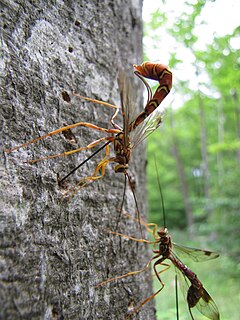
Parasitoid wasps are a large group of hymenopteran superfamilies, with all but the wood wasps (Orussoidea) being in the wasp-waisted Apocrita. As parasitoids, they lay their eggs on or in the bodies of other arthropods, sooner or later causing the death of these hosts. Different species specialise in hosts from different insect orders, most often Lepidoptera, though some select beetles, flies, or bugs; the spider wasps (Pompilidae) exclusively attack spiders.

The diamondback moth, sometimes called the cabbage moth, is a moth species of the family Plutellidae and genus Plutella. The small, grayish-brown moth sometimes has a cream-colored band that forms a diamond along its back. The species may have originated in Europe, South Africa, or the Mediterranean region, but it has now spread worldwide.

The Plutellidae are a family of moths commonly known as the diamondback moths, named after the diamondback moth of European origin. Some authors consider this family to be a subfamily of the Yponomeutidae, but it is usually considered to be a family in its own right, and have three subfamilies, Plutellinae, Praydinae, and Scythropiinae.

The leek moth or onion leaf miner is a species of moth of family Acrolepiidae and the genus Acrolepiopsis. The species is native to Europe and Siberia, but is also found in North America, where it is an invasive species. While it was initially recorded in Hawaii, this was actually a misidentification of Acrolepiopsis sapporensis.
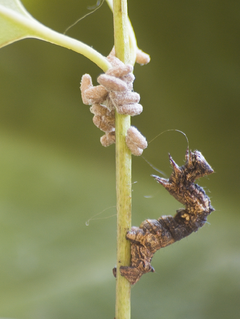
Glyptapanteles is a genus of endoparasitoid wasps found in Central and North America and New Zealand. The larvae of the members of Glyptapanteles sp. are distinguished by their ability to manipulate their hosts into serving as bodyguards.
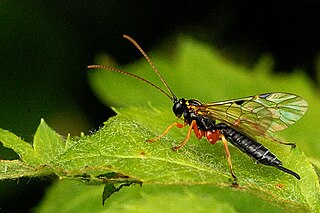
Pimplinae are a worldwide subfamily of the parasitic wasp family Ichneumonidae.

Campopleginae is a large subfamily of the parasitoid wasp family Ichneumonidae with a world-wide distribution. Species in this subfamily have been used in the biological control of the alfalfa weevil, clover weevil, various species of Heliothis, oriental army worm, European corn borer, larch sawfly, and others.

The Ibaliidae are a small family of hymenopteran superfamily Cynipoidea. Ibaliidae differ from most of the cynipoids by the larvae being parasitoids on other wasp larvae in the group Siricidae. The Ibaliidae comprise three extant genera of fairly large wasps, with a total of 20 species, and is a sister group to the rest of the cynipoids except the small subfamily Austrocynipidae.

Cotesia is a genus of braconid wasps first described by Peter Cameron in 1891. Some species parasitize caterpillars of species considered pests, and are used as biocontrol agents. Cotesia congregata parasitizes the tomato and the tobacco hornworms. C. glomerata and C. rubecula feed on the cabbage white and other white butterfly caterpillars. C. gonopterygis and C. risilis are host-specific and parasitize the common brimstone.
Diadegma patruele is a wasp first described by Holmgren in 1868. It is found in South Africa.
Diadegma insulare is a wasp first described by Ezra Townsend Cresson in 1865. No subspecies are listed. It is a parasitoid of the diamondback moth, which is a pest of cruciferous crops.
Diadegma capense is a wasp first described by P. Cameron in 1906. No subspecies are listed.
Cotesia rubecula is a parasitoid wasp from the large wasp family Braconidae.
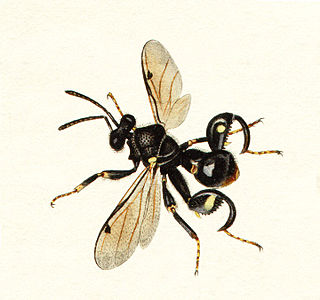
Chalcis is a wasp genus in the tribe Chalcidini.
Josephine Christina Cardale worked as an entomologist for CSIRO from 1967 to 2001. She was a collection manager of Hymenoptera at the Australian National Insect Collection.
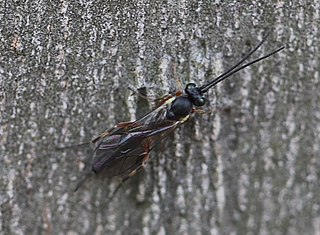
Diadegma semiclausum is a species of parasitic wasp in the family Ichneumonidae. Its larvae are parasites of the larvae of the diamondback moth and certain other moths.
References
- ↑ "Diamondback moth". Agricultural Research Council. Archived from the original on October 15, 2006. Retrieved September 16, 2013.
- ↑ "Species Page - Diadegma mollipla". Entomology Collection. University of Alberta E.H. Strickland Entomological Museum. Archived from the original on September 16, 2013.
- ↑ Rossbach, A.; Löhr, B. & Vidal, S. (2008). "Interspecific competition between Diadegma semiclausum Hellen and Diadegma mollipla (Holmgren), parasitoids of the diamondback moth, Plutella xylostella (L), feeding on a new host plant". Bulletin of Entomological Research. 98 (2): 135–43. doi:10.1017/S0007485307005482. PMID 18062837.